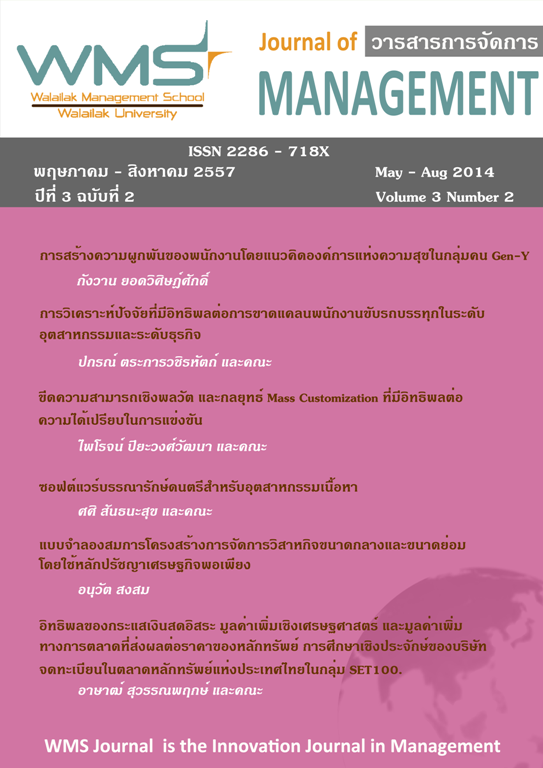Dynamic Capabilities and Mass Customization Strategy Influencing on Competitive Advantage
Main Article Content
Abstract
Article Details
References
การท่องเที่ยวและการกีฬาแห่งประเทศไทย. 2555. สรุปสถานการณ์โรงแรม ประจำปี 2555. กรุงเทพมหานคร: ผู้แต่ง.
การท่องเที่ยวและการกีฬาแห่งประเทศไทย. 2555. สรุปสถานการณ์โรงแรม ประจำปี 2555. กรุงเทพมหานคร: ผู้แต่ง.
ไพโรจน์ ปิยะวงศ์วัฒนา. “สมรรถภาพหลักองค์กรเพื่อความได้เปรียบเชิงการแข่งขัน”, วารสารทรัพยากรมนุษย์. ปีที่ 2 ฉบับที่ 2 พฤษภาคม-ธันวาคม 2549 มหาวิทยาลัยธรรมศาสตร์.
สำนักงานเทศบาลหัวหิน. 2555. สรุปรายงานผู้ประกอบการในธุรกิจท่องเที่ยว ประจำปี 2555.
สำนักงานเทศบาลชะอำ. 2555. สรุปรายงานผู้ประกอบการในธุรกิจท่องเที่ยว ประจำปี 2555.
http://phetchaburi.mots.go.th/ เข้าถึงเมื่อวันที่ 16 ตุลาคม 2555.
http://www.tourism.go.th เข้าถึงเมื่อวันที่ 29 เมษายน 2556.
Argyris, C., & Schon.D.,. 1978. Organizational Learning. M.A.: Addison-Wesley,Reading.
Barney, J. 1991. Firm resources and sustainable competitive advantage. Journal of Management, 17(1): 199-120.
Barreto, I. 2010. Dynamic capabilities: A review of past research and an agenda for the future. Journal of Management, 36(1): 256-280.
Berger, J. 1997. Applying Performance Tests in Hotel Management Agreements. Cornell Hotel & Restaurant Administration Quarterly, 38(2): 25-31.
Berman, B. (2002). Should your firm adopt a mass customization strategy ? Business Horizons, 45(4), 51-60.
Bozec, R., & Breton, G. 2003. The impact of the corporatization process on the financial performance of Canadian state-owned enterprises. The International Journal of Public Sector Management, 16(1): 27.
Brotherton, B., & Adler, G. 1999. An integrative approach to enhancing customer value and corporate performance in the international hotel industry. International Journal of Hospitality Management, 18(-): 261-272.
Burns, T., & Stalker, G.M.,. 1961. The management of innovation. London: Tavistock Press.
Capron, L., & Mitchell, W.,. 2009. Selection capability: How capability gaps and internal social frictions affect internal and external strategic renewal. Organization Science, 20(2): 294-312.
Collis, D. 1994. Research note: How valuable are organizational capabilities? Strategic Management Journal, 15(Winter Special Issue): 143-152.
Davis, S. 1996. Future Perfect (10 ed.). NewYork: Addison-Wesley.
Denton, G. A., & White, B. 2000. Implemention a Balanced-scorecard Approach to Managing Hotel Operations. Cornell Hotel & Restaurant Administration Quarterly.
Diamantopoulos, A., & Siguaw,J. 2000. Introducing LISREL Great Britain: Athenaeum Press.
Eisenhardt, K., & Martin, J.,. 2000. Dynamic capabilities: What are they? Strategic Management Journal, 21(10/11): 1105-1121.
Enz, C. A., Canina, L., & Walsh, K. 2001. Hotel-Industry Averages: An Inaccurate Tool for Measuring Performance. Cornell Hotel & Restaurant Administration Quarterly, 42(6): 22-32.
Frutos, J. D., & Borenstein, D. 2004. A framework to support customer-company interaction in mass customization environments. Computers in Industry, 54(-): 115-135.
Fulderson, B. 1997. A response to dynamic change in the market place. Decision Support Systems, 21(-): 199-214.
Hamel, G. & Prahalad, C.K.,1994. Competing for the Future:Breakthrough strategies for seizing control of your industry and creating the markets of tomorrow,Boston:Harvard Business School Press.
Hannan, M. T., & Freeman, J.,. 1977. The population ecology of organizations. American Journal of Sociology, 82(5): 929-964.
Hart, C. W. L. 1995. Mass customization: Conceptual underpinnings, opportunities and limits. Internaltional Journal of Service Industry Management, 6(2): 36-45.
Hart, C. W. L. (1996). Made to Order: Technology is making it feasible to reach that market of one, make sure you’re the first mover. Marketing Management Summer, 5(2), 11-22.
Helfat, C. E., & Peteraf, M.,. 2003. The dynamic resource-based view: Capability lifecycles. Strategic Management Journal, 24(10): 997-1010.
Helfat, C. E., and Other. 2007. Dynamic Capabilities Understanding Strategic Change In Organizations. Victoria: Blackwell.
Hill, C., W.L., & Jones, G. R. 2004. Strategic Management: An Integrated Approach (6 ed.). Boston: Houghton Mifflin Company.
Jiang, P. 2000. Segment-based mass customization: an exploration of a new conceptual marketing framwork. Internet Research, 10(3): 215-222.
Lavie, D. 2006. Capability reconfiguration: An analysis of incumbent responses to technological change. Academy of Management Review, 31(1): 153-174.
Lawrence, P. L., J.,. 1967. Differentiation and integration in complex organizations. Administrative Science Quarterly, 12(1): 1-47.
Lewin, A. Y., & Volberda, H.W. 1999. Prolegomena on coevolution: A framework for research on strategy and new organizational form. Organization Science, 10(5): 519-534.
McGivern, M. H., & Tvorik, S. J. 1997. Derterminants of Organizational Performance. National Real Estate Investor, 35(6): 417-435.
Miles, R. E., & Snow, C.C. 1978. Organizational Strategy, Structure & Process. New York: McGraw-Hill.
Obaidat, S. K. 1987. Industry Structure,Strategy, and Performance. Unpublished Doctor of Philosophy, City University of New York.
Pavlou, P., & Sawy, EI.,. 2006. From it leveraging competence to competitive advantage in turbulent environments: The case of new product development. Information Systems Research, 17(3): 198-227.
Piccoli, G., O'Connor, P., Capaccioli, C. & Alvarez, R. 2003. Customer relationship management--a driver forchange in the structure of the U.S. lodging industry. Cornell Hotel & Restaurant Administration Quarterly, 44(i4): 5-14.
Pine II, B. J. 1993. Mass Customization: The New Frontier in Business Competition. Boston: Harvard Business School Press.
Porter, M. E. 1980. Competitive Strategy: Techniques for Analyzing Industries and Competitors. New York: Free Press.
Porter, M. E. (1985). Competitive advantage: Creating and sustaining superior performance. New York: Free Press.
Santos-Vijande,M.L.,Lopez-Sanchez, J.A., & Trespalacios, J.A. 2012. How organizational learning affects a firm’s flexibility, competitive strategy and performance. Journal of Business Research, 65: 1079-1089.
Schermelleh-Engel., M., H., & Muller, H.,. 2003. Evaluating the fit of structural equation models: Tests of significance and descriptive goodness-of-fit measures. Mothods of psychological Research Online, 8(2): 23-74.
Song,Ji-Hoon,Jeung,C-W, & Cho,S-H,.2012. The impact of the learning organization environment on the organizational learning process in the Korean business context.The Learning Organization, 18(6): 468-485.
Srinivanan, D. 1997. Relation Between Financial and Nonfinancial Measures of Performance. University of Minnesota.
Teece, D. J., Pisano, G., & Schuen, A.,. 1997. Dynamic Capabilities and Strategic Management. Strategic Management Journal, 18(7): 509-533.
Teece, D. J. 2007. Explicting dynamic capabilities: The nature and microfoundations of (sustainable) enterprise performance. Strategic Management Journal, 28(13): 1319-1350.
Verona, G., & Ravasi, D.,. 2003. Unbundling dynamic capabilities: An exploratory study of continuous product innovation. Industrial and Corporate Change, 12(3): 577-606.
Winter, S. G. 2003. Understanding dynamic capabilities. Strategic Management Journal, 24(October Special Issue): 991-995.
Wu, L. 2010. Applicability of the resource-based and dynamic-capability views under environmental volatility. Journal of Business Research, 63(1): 27-31.
Wulf, K. D., Odekerken-Schroder, G., & Lacobucci, D. 2001. Investments in consumer relationships: A cross-country and cross-industry exploration. Journal of Marketing, 65(4): 33.
Yamin, S., Gunasekaran, A., & Mavondo, F.T. 1999. Relationship between generic strategies, competitive advantage and organizational performance: an empirical analysis. technovation, 19: 507-518.


